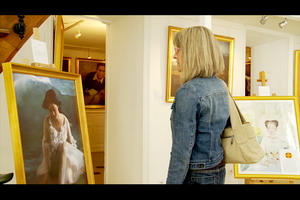The Art of Zhen, Shan, Ren in the Town of Caen, France: “Absolutely Magnificent!” (Photos)
(Minghui.org) The Art of Zhen, Shan, Ren International Exhibition, exhibited worldwide in over 40 countries and 200 towns, is now being shown in France. It has just been shown for the sixth time in France and for the first in the town of Caen. The Galerie Place des Arts hosted the exhibition from April 19-23.
The Art of Zhen, Shan, Ren International Exhibition is both intimate and inspiring. The theme is the tragedy of the persecution of Falun Gong practitioners in China and the depth of their spirituality. The works are mainly oil paintings and Chinese pastels. Viewers are deeply moved as much by the artistic quality of these works as by the expression of powerful reality and hope that radiate from them.

Veronique Le Madec: “The paintings are more than truthful”
Veronique Le Madec, a painter, found the exhibition “very touching” because “the pictures are more than truthful. Unfortunately, this kind of thing [persecution] is still happening... as a human being I am very touched and as a painter, I already knew that I enjoyed freedom of speech, but this is much more than that.”
She was especially affected by the painting “Tears of Grief and Joy” in which the painter gives his impression of the Last Judgment. “The whirlwind of colors! If I don't look at the details, I only see the color and the 'S' shape and that way I find the painting brimming over with hope. But, in fact, the story is exactly the opposite: if you go closer and see all the wretchedness in this painting, the artist has transformed it and he has got his message across through color,” she explained.
“I'm very pleased to have come here, sincerely pleased, and I would really like to encourage people to come and to take their time to read the narratives and not just be content with only looking at the picture, but to read all the little commentaries, that's very important. It is important to let the message behind the paintings be known.”

Bernard Zeller: “I have seldom seen such a forceful, such a powerful exhibition”
Painter Bernard Zeller was very moved by the strength of the message of the exhibition. “I believe I have seldom seen an exhibition as forceful, as powerful as this. In fact, it's overwhelming. The paintings seem quite simple. You like the first pictures, they are easy to understand and then... you find that it's more powerful than reality. The style is modern, but reminds one of tradition, it's overwhelming,” he explained. “I discovered through this exhibition that people are persecuted for their belief. It is hard to acknowledge!” he added.
The painting “Tears of Grief and Joy” struck many visitors. Among them was Valerie Huart, town councilor, painter, and art teacher. “It's a wonderful painting and it explains everything. One is touched just by looking at it,” she said. As for the pictures showing the persecution of Falun Gong practitioners, she said, “I wanted to cry at each of the pictures. Each time I read the text and looked at the painting, it was so emotional; I still feel like crying.”

Annick Fijalkowski: “I am completely overcome”
Annick Fijalkowski said, “I was very moved both by the beauty of the paintings and the horrors that are happening [in China] of which we know nothing. I just discovered that today--I didn't know about it before. It makes you want to cry. It's horrible, it must stop! It's serious! It's unbearable! I am completely overcome!” She was especially drawn to the painting “Who Am I?” because “it is a question we all ask ourselves, especially when we get older.” She added, “In a way, the world is very beautiful, but there are many horrible things, too.”
Oksana Charlot, an amateur painter who attended courses at the Academy of Arts of St. Petersburg in Russia, gave her impression of the technique used in the works: “The minute I came in, I spotted what I found interesting: the figurative and the realist paintings in the classical tradition. You seldom see interesting things in contemporary art these days.”
Ms. Charlot explained: “In coming to the exhibition, I was interested to find out how the artists, most of them Chinese, bring together this absolutely traditional approach to painting and the European approach. There is something here that speaks of another civilization, another mythology, and because of this, what is implied in the paintings is different.”
She spoke of her artistic understanding of the torture and other scenes of suffering, saying, “You see that in a scene showing suffering, the suffering body has retained all its beauty. These models are drawn in the ancient classical style, the proportions are classical, no part of the body is deformed, all is smooth. One understands that this represents the victory of the spirit over torture, it's visible in the choice of forms, of light and shade.” Looking at the painting “Tragedy in China,” she explained, “It's in the classical style, it's static. The overall picture is interesting with its modern clothes still intact, the woman suffering is beautiful in her suffering. What is being spoken of here is the question of life and death, and it is treated with so much symbolism.”

Visitors contemplate the paintings
The memory of this exhibition will certainly linger on in the minds of those who visited the gallery and discovered these paintings. “Quite simply magnificent” was one of the messages left in the visitor's book. Another read, “A very moving exhibition because of the veracity of the subject.” Others thanked the gallery for the opportunity they had been given to learn about the repression of Falun Gong in China: “Thank you for awakening our consciences” and “Go on denouncing this horror.”
The next exhibition of The Art of Zhen, Shan, Ren in France will be in Perigueux from May 21 to 25, 2013.
Original French version: http://fr.minghui.org/articles/2013/5/7/43354.html